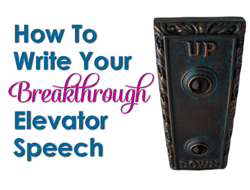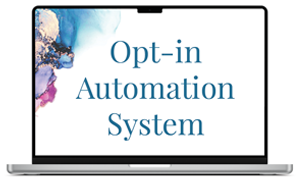
When someone asks you, “What do you do?” this is your golden opportunity to shine. I’m as guilty as any of giving the standard answer “I’m in ___.” That’s a conversation stopper, not a conversation starter!
What people are really asking is: who are you, who are your people, how do you spend your time, and what is your passion, as a way to get to know you and put you in a nice cozy box in their brains. All that packed into one socially accepted general phrase “what do you do?”
Let’s find a way to engage when someone asks us that inevitable question “what do you do?” with our breakthrough elevator speech.
One of my first clients was a leadership coach. In our first meeting, I asked what she told people when someone asked what she did and she said, “I say I’m an executive leadership coach.” Then I asked her, what’s the result of working with you? And she said “I help people breakthrough barriers and create a clear path to get them to the next step in their career.” BINGO! That’s what we decided as how she should answer the ‘what do you do question’, as 90% people ask right after that, oh really, ‘how do you do that?’ Then she can say she’s an executive leadership and career transition coach.
You can do the same by stating the benefit, your target market, and/or result of your work first. Take a look at the samples below, column A is the “status quo” answer, column B is the benefit statement.
Column A Column B
I make hula hoops. I design colorful, handmade fitness hoops for adults and children, and teach people how to jump through them gracefully.
I’m a knitter. I handcraft knitted keepsakes for children that make grandmas jealous.
I make and sell jewelry. I custom design monogrammed jewelry for trendy teens and budget-conscious mamas.
I write ad copy. I use my writing talents to catapult client’s sales!
I’m a stock broker. I help people save money for their dream life.
I’m an artist. I (paint/illustrate/draw/print) custom pieces for (modern/vintage/shabby chic) décor. Or: I create art that pulls a room together.
I’m a photographer. I artistically capture memorable moments in people’s lives.
You get the trend. The key here is to wording your business in a way that states the benefit of doing business with you (like a helping statement), and who benefits (your ideal customer) from doing business with you, and what the end result is—what every customer wants.
Think about why you started your business in the first place–the story of what brought you to this moment, right now. See if you can compact/distill the why of your business into one, short, easy-to-memorize sentence with the structure above. Be detailed in your description, such as with the artist example. You could specify what medium you use, what style you’re influenced by, what themes you typically use, where your art would be showcased best in a home, what type of customer your work appeals too, etc. This is really all dependent on you.
Currently, as a marketing consultant for small businesses, my breakthrough elevator speech is: I help small businesses create a solid online presence that connects them with their ideal customers.
Next is to memorize your elevator speech. Practice saying it out loud, like in the shower, until it comes naturally to you, and then test it in your next social situation. Don’t feel bad if you fall back into your old standard. That just means you need to rehearse a little more until you can say it comfortably and confidently.
If something doesn’t feel right to you in your sentence, change or tweak it as needed. As you business evolves, this short descriptor evolves, so come back to it regularly and don’t be afraid to change your story as needed.
TAKE AWAY TIP: You can use your elevator speech as your short bio/description for online social profiles such as Twitter, your Facebook Business Page, LinkedIn, Etsy, Artfire, Ebay, forums, and more! The key is to keep it consistent across all of your platforms.

